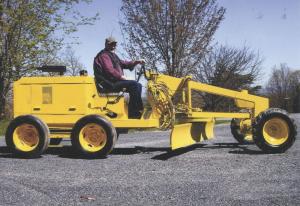2013 - Volume #37, Issue #4, Page #04
[ Sample Stories From This Issue | List of All Stories In This Issue | Print this story
| Read this issue]
4-WD Road Grader Built From Scratch
 |
The machine rides on 6 wheels and is equipped with a 6 1/2-ft. wide blade. The four 15-in. powered wheels on back are off a Jeep Wagoneer and are mounted backward, and the 15-in. lugged steering wheels on front are off an old Gravely tractor.
“I use it on my small farm to grade my driveways and farm lanes. I built it almost entirely from scratch,” says Hockenberry, who is a retired machinist. “I started with an older Cub Cadet but soon realized it was too small and not heavy or powerful enough. The only thing left of the old Cadet is the seat and steering wheel.”
The machine is powered by a 37 hp, 4-cyl. Wisconsin engine, a Ford clutch/flywheel, and a pair of right angle gearboxes. The gearboxes power two 3-speed transmissions, one off a GM car and the other off an IH Scout. “I needed to use two transmissions in order to get the ground speed low enough,” says Hockenberry.
He built his own 4-WD system. The rear axle is off an old homemade tractor that he found at a salvage yard, and he used 2-in. cold rolled steel to build the front axle. The rear axle’s brake drums chain-drive the front axle. Hockenberry bought 4 big 14-in. sprockets and cut the centers out of two of them, then slid them over the brake drums and welded them on. He welded the other two sprockets to the front axle. “The bolster suspension system from an old car is built into the front wheels, which allows the wheels to raise up or down independently so the chain won’t get loose,” says Hockenberry.
The Jeep Wagoneer wheels were too narrow so he cut the centers out of the wheels, flipped them, and welded them back in to widen the wheels.
The blade is the top half of a blade designed to plow snow on front of a pickup. Hockenberry cut the blade in half lengthwise and shortened it to 6 1/2 ft. wide. Then he turned the blade upside down. A pair of hydraulic cylinders are used to change the blade angle. The cylinders hook up to a homemade yoke mounted behind the blade.
The blade rotates on two 1/4-in. thick steel plates located between the top of the blade, and a frame that extends forward to the front steering wheels and connects with a trailer hitch ball, which allows the blade to move. “The blade can go up or down, left or right, and move from side to side.”
The Wisconsin engine belt-drives a hydraulic pump that controls all blade operations. The hydraulic controls are located alongside the steering column. “I use a key on one side of the steering wheel to start the engine, and a master electric disconnect switch behind the seat.
The 3-speed Scout transmission is equipped with high and low range. “Running both transmissions in high gear would make the machine go too fast and be dangerous, so I blocked out the two high gears in the GM transmission. Now my top speed is 15 to 20 mph, and I can go slower than I can walk,” says Hockenberry. “By putting the GM transmission in low gear and the Scout transmission in low gear I can just creep along. There are two gearshift levers – one to run the GM transmission and the other to run the Scout.”
He used 4 and 6-in. channel iron to build the frame.
“It turned out well and I couldn’t be happier with it,” says Hockenberry. “By removing a few bolts I can take two side panels off for access to the starter engine. I built the front steering axle from scratch, and the steering box is off an old Plymouth car.”
Contact: FARM SHOW Followup, Jack Hockenberry, 14899 Cumberland Hwy., Orrstown, Penn. 17244 (ph 717 532-4464; cell 717 552-8058).

Click here to download page story appeared in.

Click here to read entire issue




